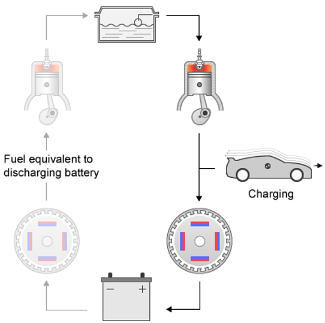Equivalent Consumption Minimization Strategy
Energy management controller for P0–P4 hybrid electric vehicles
Libraries:
Powertrain Blockset /
Propulsion /
Supervisory Controllers
Description
Use the Equivalent Consumption Minimization Strategy (ECMS) block to control the energy management of hybrid electric vehicles (HEVs). The block optimizes the torque split between the engine and motor to minimize energy consumption while maintaining the battery state of charge (SOC).
The HEV P0, P1, P2, P3, and P4 reference applications use the Equivalent Consumption Minimization Strategy block for hybrid control.
Use the Motor location parameter to specify the HEV motor location.

Use the ECMS method parameter to implement either an adaptive or non-adaptive ECMS method. The HEV architectures are charge-sustaining, meaning the battery SOC must remain in a specified range because there is no plugin capability to recharge the battery. The battery is an energy buffer, and all energy comes from the fuel if the change in SOC is minimized over a drive cycle. To sustain the charge over a specified drive cycle, the block implements either of these ECMS methods.
| ECMS Method | Description |
|---|---|
| The block uses a constant ECMS equivalence factor.
|
| The block adjusts an ECMS equivalence factor by using the output of a PI controller.
|
ECMS Control Algorithm
The block implements a dynamic supervisory controller that determines the engine torque, motor torque, starter, clutch, and brake pressure commands. Specifically, the block:
Converts the driver accelerator pedal signal to a wheel torque request. To calculate the total powertrain torque at the wheels, the algorithm uses the maximum engine torque and motor torque curves and the transmission and differential gear ratios.
Converts the driver brake pedal signal to a brake pressure request. The algorithm multiplies the brake pedal signal by a maximum brake pressure.
Implements a regenerative braking algorithm for the traction motor to recover the maximum amount of kinetic energy from the vehicle.
The block implements an ECMS algorithm[2] that optimizes the torque split between the engine and motor to minimize energy consumption while maintaining the battery SOC. Specifically, the ECMS:
Assigns a cost to electrical energy, so that using stored electrical energy is equal to consuming fuel energy.
Battery Mode Equivalent Electrical Energy Description Discharging
Positive
Battery discharges stored electrical energy when the electric machine is in use.

Charging
Negative
Battery stores electrical energy from either the:
Engine and electric machine acting as a generator
Electric machine acting as a generator during regenerative braking

Is an instantaneous minimization method that the software solves at every controller time step. To implement the strategy, the ECMS selects the optimal motor and engine torque in the optimization strategy to minimize the equivalent energy consumption.
Implements either an adaptive or non-adaptive ECMS method.
Examples
Ports
Input
Output
Parameters
References
[1] Balazs, A., Morra, E., and Pischinger, S., Optimization of Electrified Powertrains for City Cars. SAE Technical Paper 2011-01-2451. Warrendale, PA: SAE International Journal of Alternative Powertrains, 2012.
[2] Onori, S., Serrao, L., and Rizzoni, G., Hybrid Electric Vehicles Energy Management Systems. New York: Springer, 2016.
Extended Capabilities
Version History
Introduced in R2020b


